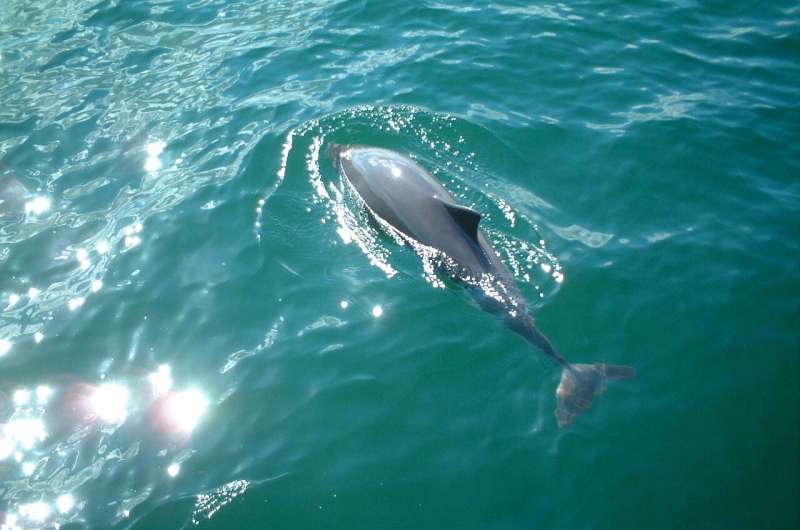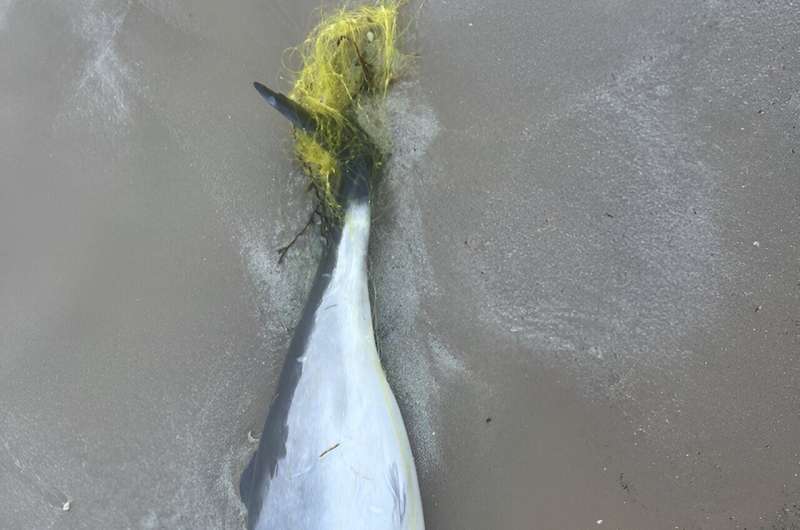This article has been reviewed according to Science X's editorial process and policies. Editors have highlighted the following attributes while ensuring the content's credibility:
fact-checked
peer-reviewed publication
trusted source
proofread
Scientists raise the alarm: Too many harbor porpoises die each year in fishing nets

Researchers from Denmark, Germany, and Sweden are sounding the alarm. In a recently published research paper, they highlight the challenges faced by harbor porpoises in Danish coastal waters and in the western part of the Baltic.
The findings are published in the journal Frontiers in Marine Science.
The harbor porpoises in that area are considered part of a single population, referred to by scientists as the Belt Sea population. Unfortunately, the number of harbor porpoises in this population has significantly declined. In 2012 and 2016, there were approximately 40,000 individuals, but by 2022, only 14,000 remained.
And it's not getting better, explains Signe Sveegaard, Senior Advisor and Head of Section of marine mammal research at the Department of Ecoscience at Aarhus University. She's also one of the researchers behind the new results.
"The population shrinks by 2.7 percent annually, which is concerning for the harbor porpoises. Multiple factors contribute to this decline. By-catch due to net fishing, where porpoises become entangled and drown, is a significant issue. Additionally, deoxygenation, pollution, and a lack of fish play a role," she says.
"Improving the polluted marine environment and fish availability will take many years. However, an immediate solution lies in limiting net usage in commercial fishing or mandating the use of acoustic alarms on all nets."
Counting porpoises from the air
Since 2005, researchers have conducted continuous counts of harbor porpoises. They divide the ocean into smaller segments and systematically fly over these areas, scouting for porpoises on the surface.
"We count all the porpoises we can spot in the ocean. From other studies, we know that harbor porpoises stay at the surface approximately 10 percent of the time. By multiplying the number of spotted porpoises in the area and adding the multiplied numbers for all the studied areas up, we estimate the whole population," says Sveegaard.
"It's the best way of counting harbor porpoises, but the method is still fraught with uncertainty. That aside, we do have comparable data from 2005 till today, which means we can calculate a trend. And the trend is quite clear: The harbor porpoise is in decline."
As a matter of fact, the harbor porpoises fared better from 2011 until 2016. In those years, the population was growing, but after 2016, the trend was broken. Now, the researchers observe fewer harbor porpoises than in 2005 when they started counting.
Harbor porpoises in the Belt Sea
Today, around 14,000 harbor porpoises live in the Belt Sea, a coastal area divided by Denmark, Sweden, and Germany.
The harbor porpoises in the area are considered one population, even though some of them live hundreds of miles apart. They are genetically different from the populations in the North Sea and the Baltic Sea.
Harbor porpoises migrate to find food. This means that the harbor porpoises are not evenly distributed in the Belt Sea but crowd together in areas that have an abundance of food. They are mainly found in the Femern Belt, the northern part of Øresund, Storebælt, Lillebælt, and in Kattegat along the Swedish west coast.

Researchers worried about the fishing industry
Even though the fishing industry isn't the only thing affecting the harbor porpoises, the researchers are especially focused on the threat that commercial fishing poses.
"We mention the fishing industry and by-catch specifically because it's the only way to make a change here and now. If the politicians decide to limit net fishing, it will quickly reduce the by-catch of harbor porpoises and give the population time to heal," says Sveegaard.
She's worried about the political debate about commercial fishing right now because the focus is on limiting the use of bottom trawl.
"Right now, they debate whether the use of bottom trawl is to be limited. Studies clearly show that bottom trawl is very harmful to ecosystems in the sea and thereby affects the availability of food for harbor porpoises. That said, I'm worried about limiting the use of bottom trawl because the fishing industry most likely will use more nets instead. If that happens, it will probably lead to even more by-catch of harbor porpoises."
Young porpoises caught in the net
While populations of herring and codfish, which lay millions of eggs, are able to bounce back quickly, harbor porpoises only have one calf a year. That means it takes many years for a harbor porpoise population to grow and stabilize, Sveegaard explains.
Right now, the harbor porpoise population is under pressure because the calves are the ones who usually get caught in the nets of fishing vessels.
"The harbor porpoises reach maturity when they are about four years old, but they leave their mother after only one year. For three years, they swim around the ocean all on their own, not being able to reproduce. They are inexperienced and are much more likely to get caught in a net than adult harbor porpoises. That is a huge problem because the new generations don't survive long enough to have kids. In time, it could make the whole population collapse."
Cousins in the North Sea fare better
While the harbor porpoises in the Belt Sea are declining, it looks quite different for the porpoises in the North Sea. Here, the population has been stable for many years. From 1994 to 2022, the population stayed between 300,000 and 400,000.
"The harbor porpoises of the North Sea fare better. It's probably because they have more space to move around and follow the shoals of fish. And they have moved. When we started counting them, they were mostly living in the northern part of the North Sea. Today, many of them have gone south past Dogger Bank towards the English Channel," Sveegaard says.
In the Belt Sea, the harbor porpoises can't move around in the same way as their cousins in the North Sea. The area is much smaller, and furthermore, they are specialized in catching fish in shallow waters.
"We know from studies of the skulls of harbor porpoises that the populations are quite different from each other. The population in the Belt Sea has a downturned beak, whereas in the North Sea, the beaks are more horizontal. It's probably because the population in the North Sea are specialized in catching fish directly from the water column. In the Belt Sea, the porpoises have instead specialized in catching bottom-dwelling fish."
Because the harbor porpoises of the North Sea have adapted to a different environment, it's unlikely that they will be able to repopulate the Belt Sea if the population here disappears. That's why it's extremely important to protect the harbor porpoises where they live, she explains.
"If the harbor porpoises of the Belt Sea disappear, they might never come back. Therefore, we need to do something now to protect and stabilize the population."
More information: Kylie Owen et al, A negative trend in abundance and an exceeded mortality limit call for conservation action for the Vulnerable Belt Sea harbour porpoise population, Frontiers in Marine Science (2024). DOI: 10.3389/fmars.2024.1289808
Journal information: Frontiers in Marine Science
Provided by Aarhus University




















